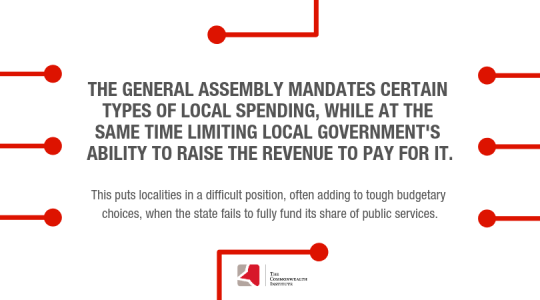March 20, 2019
Raising Local Resources: Virginia Localities Do What They Can — And Could Do More with State Help
In Virginia, public services such as education, health, and public safety are often undertaken in partnership between the state and local governments. This partnership may seem a bit lopsided at times, however, as local governments have limited flexibility due to tight state restrictions. Because of a U.S. legal concept commonly referred to as “Dillon’s Rule,” Virginia’s localities lack true home rule and only have the powers expressly granted to them by the Virginia General Assembly. And the General Assembly has chosen to assign localities broad responsibilities and mandate certain types of local spending, while at the same time limiting their ability to raise the revenue to pay for it. This puts localities in a difficult position, often adding to tough budgetary choices, when the state fails to fully fund its share of public services. Any discussion of local revenue proposals must have these serious constraints in mind.

Although Virginia’s local governments may levy real and personal property taxes, sales and use taxes, meals taxes, and a few other taxes, the state government limits which localities may levy which taxes and the maximum rates of many taxes. For instance, the local sales tax is limited to 1 percent of the gross sales price of an item, and meals taxes are capped at 4 percent for most counties. Significantly, the state does not permit any localities to levy a local income tax.
Local revenue sources provide the resources for investments in schools, roads, and other services, but the taxes behind them are often not paid equally. Because of the limits set by the General Assembly, Virginia localities are reliant on regressive taxes, such as sales, excise, and property taxes which are set and paid without consideration of an individual’s ability to pay. This results in low-income families paying a higher share of their incomes toward those taxes than high-income families. Although the state allows income-based real property tax relief for elderly or disabled homeowners, it denies local governments the ability to provide income-based tax relief for working families who are struggling to make ends meet.
Reliance on regressive taxes, as well as fines and fees, has a particularly harmful financial impact on Black and Latinx families who face employment barriers that make it more likely they will have low family income. In contrast, a local income tax – which the state does not allow cities and counties to levy – could account for differences in family size and income, asking those with more ability to pay taxes to contribute more.
Without greater flexibility, a locality’s only other option to meet the needs of their residents is state funding. State aid, not including federal pass-thru dollars, represented 32.4 percent and 30.6 percent of revenues for cities and counties, respectively, in fiscal year 2017. During the Great Recession, lawmakers cut state funding for localities, and many of these cuts linger today. This impact is clearly seen when looking at our K-12 schools, where state funding next school year will remain down 7.7 percent per pupil compared to 2009.
Ultimately, unless the General Assembly grants localities additional authority to raise the resources for investments in their own communities, local governments will continue to face the same set of constraints. The state could ease these challenges by granting additional taxing authority, such as allowing local income taxes, or by boosting state aid so that local governments are not as reliant on regressive local tax sources. (The state could also enact a refundable Earned Income Tax Credit to partially offset regressive local taxes.)
Even without state action to ease the situation, local governments still need to maintain their schools, roads, parks, and libraries. Without ideal funding options, it’s no surprise local leaders are working with what they have.
Category:
Budget & Revenue
